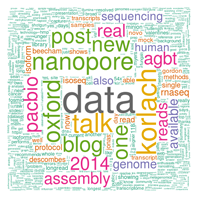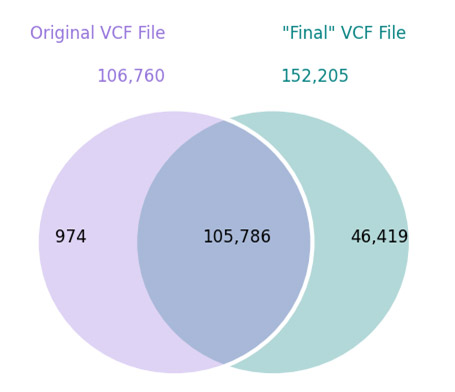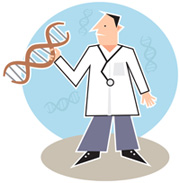About Gabe Rudy
Meet Gabe Rudy, GHI’s Vice President of Product and Engineering and team member since 2002. Gabe thrives in the dynamic and fast-changing field of bioinformatics and genetic analysis. Leading a killer team of Computer Scientists and Statisticians in building powerful products and providing world-class support, Gabe puts his passion into enabling Golden Helix’s customers to accelerate their research. When not reading or blogging, Gabe enjoys the outdoor Montana lifestyle. But most importantly, Gabe truly loves spending time with his sons, daughter, and wife. Follow Gabe on Twitter @gabeinformatics.
I was definitely an early adopter when it comes to personal genomics. In a recent email to their customer base announcing their one millionth customer, they revealed that I was customer #44,299. And I have been consistently impressed with the product 23andMe provides through their web interface to make your hundreds of thousands of genotyped SNPs accessible and useful. It… Read more »
This last week I had the pleasure of attending the fourth annual Clinical Genome Conference (TCGC) in Japantown, San Francisco and kicking off the conference by teaching a short course on Personal Genomics Variant Analysis and Interpretation. Some highlights of the conference from my perspective: Talking about clinical genomics is no longer a wonder-fest of individual case studies, but a… Read more »
Yes, I said it. “Them be fighting words” you may say. Well, it’s worth putting a stake in the ground when you have worked hard to have a claim worth staking. We have explored the landscape, surveyed the ravines and dangerous cliffs, laboriously removed the boulders and even dynamited a few tree stumps. Stake planted. Ok, so now I’m going… Read more »
Since its early release in early 2012, the population frequencies from the GO Exome Sequencing Project (ESP) – from the National Heart, Lung and Blood Institute (NHLBI) have been a staple of the genomic community. With the recent release of ExAC exome variant frequencies, the ESP has been surpassed as the largest cohort of publicly available variant frequencies (by nearly… Read more »
As VarSeq has been evaluated and chosen by more and more clinical labs, I have come to respect how unique each lab’s analytical use cases are. Different labs may specialize in cancer therapy management, specific hereditary disorders, focused gene panels or whole exomes. Some may expect to spend just minutes validating the analytics and the presence or absence of well-characterized… Read more »
In a previous blog post, I demonstrated using VarSeq to directly analyze the whole genomes of 17 supercentenarians. Since then, I have been working with the variant set from these long-lived genomes to prepare a public data track useful for annotation and filtering. Well, we just published the track last week, and I’m excited to share some of the details… Read more »
I spent a very eventful week at the Molecular TriCon in downtown San Francisco, and have been pondering the very clear trends that emerged by attending the clinical and NGS focused talks. Cancer gene panels make sense economically and as “massively parallel” tests to inform therapy, but they are bound to get more complex. Liquid biopsies of circulating tumor DNA… Read more »
If you haven’t been closely watching the twittersphere or other headline sources of the genetics community, you may have missed the recent chatter about the whole genome sequencing of 17 supercentenarians (people who live beyond 110 years). While genetics only explains 20-30% of the longevity of those with average life-spans, it turns out there is a number of good reasons… Read more »
To say the announcement of Dan MacArthur’s group’s release of the Exome Aggregation Consortium (ExAC) data was highly anticipated at ASHG 2014 would be an understatement. Basically, there were two types of talks at ASHG. Those that proceeded the official ExAC release talk and referred to it, and those that followed the talk and referred to it. Why is this… Read more »
Last week, our CEO Andreas Scherer announced our entrance into the clinical testing market with VarSeq. This week, I will be giving a webcast on Wednesday introducing this new tool and demonstrating its capabilities. (Register for the webcast) VarSeq’s focused purpose is making NGS gene testing and variant discovery efficient, scalable and accessible to users with a broad range of backgrounds and specialties. In this blog post, we will examine the use cases that VarSeq supports in more detail,… Read more »
I’m sitting in the Smithsonian Air and Space Museum basking in the incredible product of human innovation and the hard work of countless engineers. My volunteer tour guide started us off at the Wright brother’s fliers and made a point of saying it was only 65 years from lift off at Kitty Hawk to the landing of a man on the moon…. Read more »
You probably haven’t spent much time thinking about how we represent genes in a genomic reference sequence context. And by genes, I really mean transcripts since genes are just a collection of transcripts that produce the same product. But in fact, there is more complexity here than you ever really wanted to know about. Andrew Jesaitis covered some of this… Read more »
On my flight back from this year’s Molecular Tri-Conference in San Francisco, I couldn’t help but ruminate over the intriguing talks, engaging round table discussions, and fabulous dinners with fellow speakers. And I kept returning to the topic of how we aggregate, share, and update data in the interest of understanding our genomes. Of course, there were many examples of… Read more »
Tis the season of quiet, productive hours. I’ve been spending a lot of mine thinking about file formats. Actually, I’ve been spending mine implementing a new one, but more on that later. File formats are amazingly important in big data science. In genomics, it is hard not to be awed by how successful the BAM file format is. I thought… Read more »
When researchers realized they needed a way to report genetic variants in scientific literature using a consistent format, the Human Genome Variation Society (HGVS) mutation nomenclature was developed and quickly became the standard method for describing sequence variations. Increasingly, HGVS nomenclature is being used to describe variants in genetic variant databases as well. There are some practical issues that researchers… Read more »
I’m a believer in the signal. Whole genomes and exomes have lots of signal. Man, is it cool to look at a pile-up and see a mutation as clear as day that you arrived at after filtering through hundreds of thousands or even millions of candidates. When these signals sit right in the genomic “sweet spot” of mappable regions with… Read more »
My investigation into my wife’s rare autoimmune disease I recently got invited to speak at the plenary session of AGBT about my experience in receiving and interpreting my Direct to Consumer (DTC) exomes. I’ve touched on this before in my post discussing my own exome and a caution for clinical labs setting up a GATK pipeline based on buggy variants… Read more »
In preparation for a webcast I’ll be giving on Wednesday on my own exome, I’ve been spending more time with variant callers and the myriad of false-positives one has to wade through to get to interesting, or potentially significant, variants. So recently, I was happy to see a message in my inbox from the 23andMe exome team saying they had… Read more »
Join me on December 5th for a one-hour webcast as I explore my personal exome provided by the Exome Pilot project of 23andMe. Exome sequencing has seen many success stories in the realm of diagnosing highly penetrant monogenic disorders as well as in informing treatment of certain cancers. As the use of exome sequencing expands to more complex polygenic disorders… Read more »
Recently, I have been spending some time analyzing real patient data. I’m preparing for a webcast I’ll be giving in which I will walk through the process of replicating the findings of Dr. Gholson Lyon‘s study on the novel disease diagnosis he named Ogden Syndrome. Being so close to data that comes directly from clinical settings got me thinking about… Read more »








